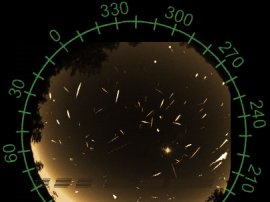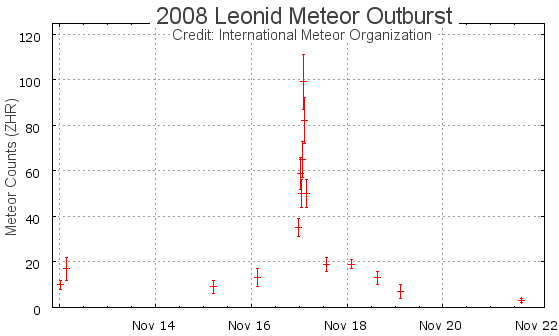|
+ Play
Audio
|
+ Download Audio | +
Email to a friend | +
Join mailing list
Dec.
4, 2008: Astronomers from Caltech and NASA say a
strong shower of Leonid meteors is coming in 2009. Their prediction
follows an outburst on Nov. 17, 2008, that broke several years
of "Leonid quiet" and heralds even more intense
activity next November.
"On
Nov. 17, 2009, we expect the Leonids to produce upwards of
500 meteors per hour," says Bill Cooke of the NASA Marshall
Space Flight Center. "That's a very strong display."
 Forecasters
define a meteor storm as 1000 or more meteors per hour. That
would make the 2009 Leonids "a half-storm," says
Jeremie Vaubaillon of Caltech, who successfully predicted
a related outburst just a few weeks ago. Forecasters
define a meteor storm as 1000 or more meteors per hour. That
would make the 2009 Leonids "a half-storm," says
Jeremie Vaubaillon of Caltech, who successfully predicted
a related outburst just a few weeks ago.
Right:
A composite, all-sky image of the 2008 Leonid outburst over
Colorado. Credit: Chris Peterson, Cloudbait Observatory. [more]
On
Nov. 17, 2008, Earth passed through a stream of debris from
comet 55P/Tempel-Tuttle. The gritty, dusty debris stream was
laid down by the Leonids' parent comet more than five hundred
years ago in 1466. Almost no one expected the old stream to
produce a very strong shower, but it did. Observers in Asia
and Europe counted as many as 100 meteors per hour.
Vaubaillon
predicted the crossing with one-hour precision. "I have
a computer program that calculates the orbits of Leonid debris
streams," he explains. "It does a good job anticipating
encounters even with very old streams like this one."
The
Nov. 17, 2008 outburst proved that the 1466 stream is rich in
meteor-producing debris, setting the stage for an even better
display in 2009.
On
Nov. 17, 2009, Earth will pass through the 1466 stream again,
but this time closer to the center. Based on the number of
meteors observed in 2008, Vaubaillon can estimate the strength
of the coming display: five hundred or more Leonids per hour
during a few-hour peak centered on 21:43 UT.
"Our
own independent model of the debris stream agrees," says
Cooke. "We predict a sub-storm level outburst on Nov.
17, 2009, peaking sometime between 21:34 and 21:44 UT."
The
timing favors observers in Asia, although Cooke won't rule
out a nice show over North America when darkness falls hours
after the peak. "I hope so," he says. "It's
a long way to Mongolia."

Above:
Meteor counts for the 2008 Leonid outburst compiled by members
of the International Meteor Organization. [more]
Many
readers will remember the great Leonid showers of 1998-2002.
The best years (1999 and 2001) produced storms of up to 3000
Leonids per hour. The 2009 display won’t be so intense. Instead,
if predictions are correct, next year's shower could resemble
the 1998 Leonids, a "half-storm"-level event caused
by a stream dating from 1333. That old stream turned out to
be rich in nugget-sized debris that produced an abundance
of fireballs. Many observers consider the 1998 Leonids to
be the best they've ever seen.
Could
2009 be the same? Vaubaillon expects a similar number of meteors
but fewer fireballs. If the models are correct, the 1466 stream
in Earth’s path contains plenty of dust but not so many nuggets,
thus reducing the fireball count. On the bright side, the
Moon will be new next Nov. 17th so nothing will stand in the
way of the shower reaching its full potential.
Mark
your calendar and stay tuned for updates from Science@NASA.
SEND
THIS STORY TO A FRIEND
Author: Dr.
Tony Phillips | Credit: Science@NASA
|
